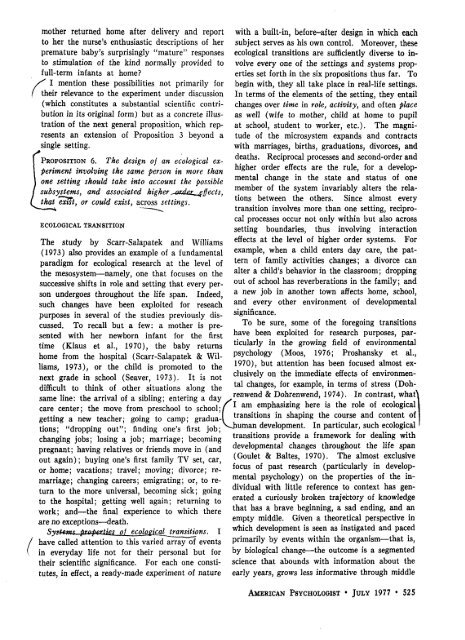Bronfenbrenner 1977
You also want an ePaper? Increase the reach of your titles
YUMPU automatically turns print PDFs into web optimized ePapers that Google loves.
mother returned home after delivery and report<br />
to her the nurse's enthusiastic descriptions of her<br />
premature baby's surprisingly "mature" responses<br />
to stimulation of the kind normally provided to<br />
full-term infants at home?<br />
S I mention these possibilities not primarily for<br />
their relevance to the experiment under discussion<br />
(which constitutes a substantial scientific contribution<br />
in its original form) but as a concrete illustration<br />
of the next general proposition, which represents<br />
an extension of Proposition 3 beyond a<br />
single setting.<br />
#<br />
PROPOSITION 6. The design of an ecological experiment<br />
involving the same person in more than<br />
one setting should take into account the possible<br />
subsystems, and associated higher<br />
that exist, or could exist, across settings.<br />
with a built-in, before-after design in which each<br />
subject serves as his own control. Moreover, these<br />
ecological transitions are sufficiently diverse to involve<br />
every one of the settings and systems properties<br />
set forth in the six propositions thus far. To<br />
begin with, they all take place in real-life settings.<br />
In terms of the elements of the setting, they entail<br />
changes over time in role, activity, and often place<br />
as well (wife to mother, child at home to pupil<br />
at school, student to worker, etc.). The magnitude<br />
of the microsystem expands and contracts<br />
with marriages, births, graduations, divorces, and<br />
deaths. Reciprocal processes and second-order and<br />
higher order effects are the rule, for a developmental<br />
change in the state and status of one<br />
member of the system invariably alters the relations<br />
between the others. Since almost every<br />
transition involves more than one setting, reciprocal<br />
processes occur not only within but also across<br />
ECOLOGICAL TRANSITION<br />
setting boundaries, thus involving interaction<br />
The study by Scarr-Salapatek and Williams effects at the level of higher order systems. For<br />
(1973) also provides an example of a fundamental example, when a child enters day care, the pattern<br />
of family activities changes; a divorce can<br />
paradigm for ecological research at the level of<br />
the mesosystem—namely, one that focuses on the alter a child's behavior in the classroom; dropping<br />
successive shifts in role and setting that every person<br />
undergoes throughout the life span. Indeed, a new job in another town affects home, school,<br />
out of school has reverberations in the family; and<br />
such changes have been exploited for reseach and every other environment of developmental<br />
purposes in several of the studies previously discussed.<br />
To recall but a few: a mother is pre-<br />
To be sure, some of the foregoing transitions<br />
significance.<br />
sented with her newborn infant for the first have been exploited for research purposes, particularly<br />
in the growing field of environmental<br />
time (Klaus et al., 1970), the baby returns<br />
home from the hospital (Scarr-Salapatek & Williams,<br />
1973), or the child is promoted to the<br />
psychology (Moos, 1976; Proshansky et al.,<br />
1970), but attention has been focused almost exclusively<br />
on the immediate effects of environmen-<br />
next grade in school (Seaver, 1973). It is not<br />
difficult to think of other situations along the<br />
tal changes, for example, in terms of stress (Dohrenwend<br />
& Dohrenwend, 1974). In contrast, what\<br />
same line: the arrival of a sibling; entering a day<br />
care center; the move from preschool to school;<br />
I am emphasizing here is the role of ecological!<br />
getting a new teacher; going to camp; gradua-l transitions in shaping the course and content of<br />
tions; "dropping out"; finding one's first job; Vhuman development. In particular, such ecological '<br />
transitions provide a framework for dealing with<br />
developmental changes throughout the life span<br />
(Goulet & Baltes, 1970). The almost exclusive<br />
changing jobs; losing a job; marriage; becoming<br />
pregnant; having relatives or friends move in (and<br />
out again) ; buying one's first family TV set, car,<br />
or home; vacations; travel; moving; divorce; remarriage;<br />
changing careers; emigrating; or, to return<br />
to the more universal, becoming sick; going<br />
to the hospital; getting well again; returning to<br />
work; and — the final experience to which there<br />
are no exceptions — death.<br />
prcpfties of ecological^transitions. I<br />
have called attention to this varied array of events<br />
in everyday life not for their personal but for<br />
their scientific significance. For each one constitutes,<br />
in effect, a ready-made experiment of nature<br />
focus of past research (particularly in developmental<br />
psychology) on the properties of the individual<br />
with little reference to context has generated<br />
a curiously broken trajefctory of knowledge<br />
that has a brave beginning, a sad ending, and an<br />
empty middle. Given a theoretical perspective in<br />
which development is seen as instigated and paced<br />
primarily by events within the organism—that is,<br />
by biological change—the outcome is a segmented<br />
science that abounds with information about the<br />
early years, grows less informative through middle<br />
AMERICAN PSYCHOLOGIST • JULY <strong>1977</strong> • 525


